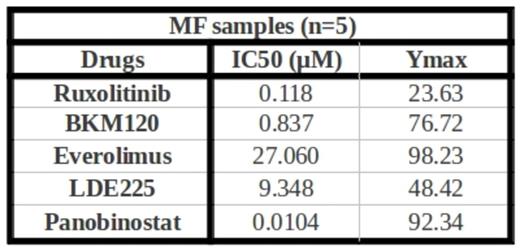Abstract
Identifying the most promising synergistic drugs combinations for a drug is a challenge for researchers. Identification of optimal combinations are key and should be translated in better designed clinical trials with fewer patients and ultimately more effective treatments. Ruxolitinib is a potent JAK1/JAK2 inhibitor that has demonstrated improved survival, rapid and durable improvements in splenomegaly, in patients with myelofibrosis (MF), however although improve survival in most of patients it does not change the natural history of the disease. There is however always a drive to improve outcomes and we hypothesize that treatment with a synergistic drug could enhance the activity in MF.
To design an ex-vivo model, based on flow cytometry, to identify the most synergistic drugs with Ruxolitinib in cell lines and primary samples from MF patients.
We have studied five secondary or primary MF patients (n = 5) and one cell line, BA/F3 transfected with mutated JAK2 V617F (BA/F3 JAK2V617F). We combined Ruxolitinib with a panel of 30 drugs whose mechanism of action is implicated in proliferation, differentiation and survival, cell-cycle inhibition, protein stabilisation, epigenetic, immune response.
Briefly, mononuclear cells from peripheral blood, isolated, was cultured in Methocult TM GF_H4535 supplemented with 20 ng/ml interleukin (IL)-3, and 50 ng/ml stem-cell factor (SCF). After 2 weeks incubation, viable cells were plated at 15.000 per well in 96-well plates in increasing concentrations of each drug, alone or in combination with Ruxolitinib, in 8 or 5 point dose response curve. After 72 hr incubation, we performed a multiparametric flow cytometry, using Annexin V-fluorescein isothiocyanate (FITC) and CD13 to monitoring drug sensibility of myeloid lineage, in the ExviTech platform for screening by flow cytometry. Synergism will be evaluated by the Median Effect methods described by T-C Chou and P. Talalay.

Combination Index of Ruxolitinib in combination with other drugs in patients with MF (n=5).

Regarding the cell line model, it confirms the results obtained in patients samples: Panobinostat was the most potent drugs tested in the assay with an IC50 of 86 nM and the most synergistic drugs with Ruxolitinib was Everolimus (CI = 0.613 when Ruxolitinib and Everolimus were 370 nM and 7.41 μM respectively).
This Vivia Ex vivo platform is highly efficient to study multiple synergisms of drugs in myeloproliferative diseases. We can test 30 drugs, inhibitors of multiple signaling pathways, epigenetics and immune response, alone or in combination with Ruxolitinib and test its activity and its potential synergy with Ruxolitinib. Based in these results, clinical trials combination Ruxolitinib with BKM120 (ongoing), Everolimus and LDE225 (ongoing) could potentially be explored in phase I clinical trials.
Hernandez-Campo:Vivia Biotech: Employment. Primo:Vivia Biotech: Employment. Ballesteros:Vivia Biotech: Equity Ownership. Martínez-López:Vivia Biotech: Honoraria; Novartis: Research Funding.
Author notes
Asterisk with author names denotes non-ASH members.

This feature is available to Subscribers Only
Sign In or Create an Account Close Modal